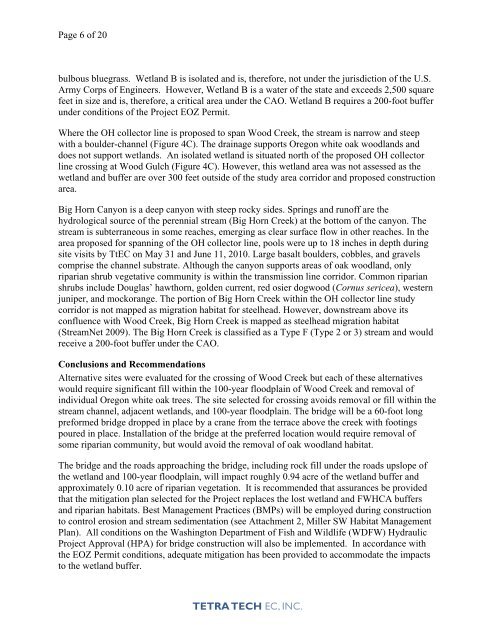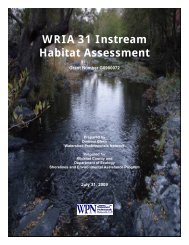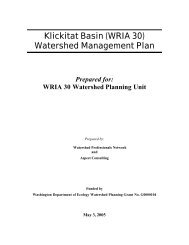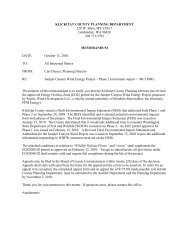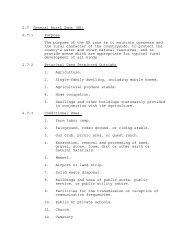Miller Wind Ranch Layout Revision Letter and HCP
Miller Wind Ranch Layout Revision Letter and HCP
Miller Wind Ranch Layout Revision Letter and HCP
- No tags were found...
You also want an ePaper? Increase the reach of your titles
YUMPU automatically turns print PDFs into web optimized ePapers that Google loves.
Page 6 of 20bulbous bluegrass. Wetl<strong>and</strong> B is isolated <strong>and</strong> is, therefore, not under the jurisdiction of the U.S.Army Corps of Engineers. However, Wetl<strong>and</strong> B is a water of the state <strong>and</strong> exceeds 2,500 squarefeet in size <strong>and</strong> is, therefore, a critical area under the CAO. Wetl<strong>and</strong> B requires a 200-foot bufferunder conditions of the Project EOZ Permit.Where the OH collector line is proposed to span Wood Creek, the stream is narrow <strong>and</strong> steepwith a boulder-channel (Figure 4C). The drainage supports Oregon white oak woodl<strong>and</strong>s <strong>and</strong>does not support wetl<strong>and</strong>s. An isolated wetl<strong>and</strong> is situated north of the proposed OH collectorline crossing at Wood Gulch (Figure 4C). However, this wetl<strong>and</strong> area was not assessed as thewetl<strong>and</strong> <strong>and</strong> buffer are over 300 feet outside of the study area corridor <strong>and</strong> proposed constructionarea.Big Horn Canyon is a deep canyon with steep rocky sides. Springs <strong>and</strong> runoff are thehydrological source of the perennial stream (Big Horn Creek) at the bottom of the canyon. Thestream is subterraneous in some reaches, emerging as clear surface flow in other reaches. In thearea proposed for spanning of the OH collector line, pools were up to 18 inches in depth duringsite visits by TtEC on May 31 <strong>and</strong> June 11, 2010. Large basalt boulders, cobbles, <strong>and</strong> gravelscomprise the channel substrate. Although the canyon supports areas of oak woodl<strong>and</strong>, onlyriparian shrub vegetative community is within the transmission line corridor. Common riparianshrubs include Douglas’ hawthorn, golden current, red osier dogwood (Cornus sericea), westernjuniper, <strong>and</strong> mockorange. The portion of Big Horn Creek within the OH collector line studycorridor is not mapped as migration habitat for steelhead. However, downstream above itsconfluence with Wood Creek, Big Horn Creek is mapped as steelhead migration habitat(StreamNet 2009). The Big Horn Creek is classified as a Type F (Type 2 or 3) stream <strong>and</strong> wouldreceive a 200-foot buffer under the CAO.Conclusions <strong>and</strong> RecommendationsAlternative sites were evaluated for the crossing of Wood Creek but each of these alternativeswould require significant fill within the 100-year floodplain of Wood Creek <strong>and</strong> removal ofindividual Oregon white oak trees. The site selected for crossing avoids removal or fill within thestream channel, adjacent wetl<strong>and</strong>s, <strong>and</strong> 100-year floodplain. The bridge will be a 60-foot longpreformed bridge dropped in place by a crane from the terrace above the creek with footingspoured in place. Installation of the bridge at the preferred location would require removal ofsome riparian community, but would avoid the removal of oak woodl<strong>and</strong> habitat.The bridge <strong>and</strong> the roads approaching the bridge, including rock fill under the roads upslope ofthe wetl<strong>and</strong> <strong>and</strong> 100-year floodplain, will impact roughly 0.94 acre of the wetl<strong>and</strong> buffer <strong>and</strong>approximately 0.10 acre of riparian vegetation. It is recommended that assurances be providedthat the mitigation plan selected for the Project replaces the lost wetl<strong>and</strong> <strong>and</strong> FWHCA buffers<strong>and</strong> riparian habitats. Best Management Practices (BMPs) will be employed during constructionto control erosion <strong>and</strong> stream sedimentation (see Attachment 2, <strong>Miller</strong> SW Habitat ManagementPlan). All conditions on the Washington Department of Fish <strong>and</strong> Wildlife (WDFW) HydraulicProject Approval (HPA) for bridge construction will also be implemented. In accordance withthe EOZ Permit conditions, adequate mitigation has been provided to accommodate the impactsto the wetl<strong>and</strong> buffer.


